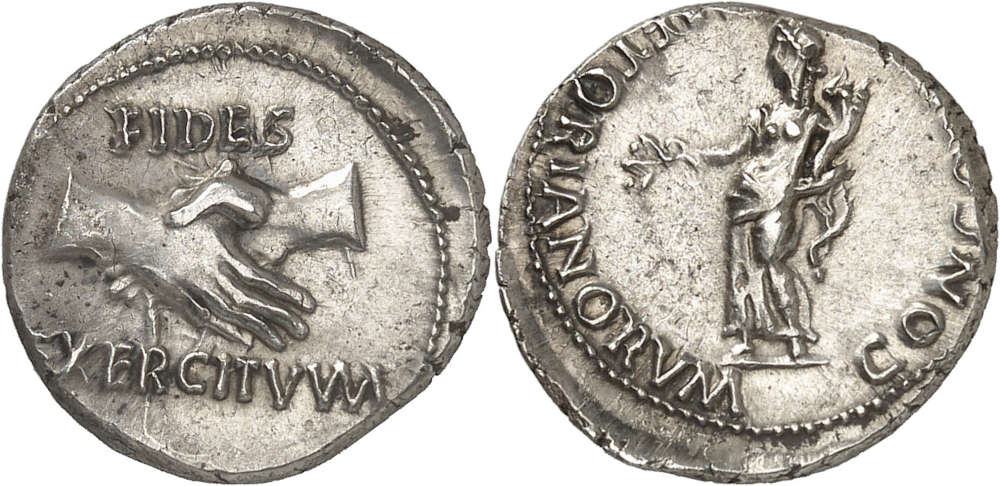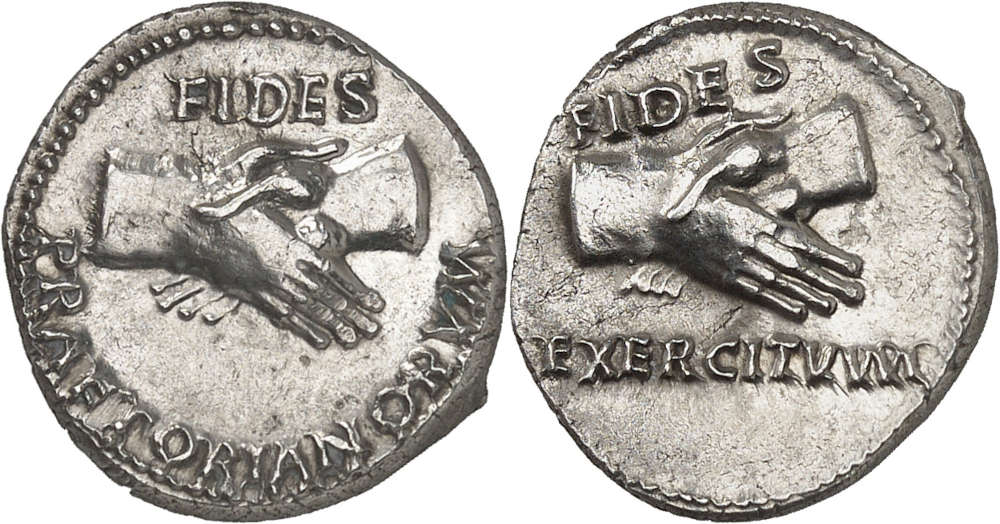The Roman Civil War of 68/9: The Prelude to the Year of the Four Emperors
by Ursula Kampmann on behalf of Heidelberger Münzhandlung
Heidelberger Münzhandlung will offer a series of coins of impeccable quality struck during the Roman Civil War at its auction on 12 and 13 November 2024. We take advantage of this opportunity to examine the historical background of these issues, going back to a time when counter-emperors did not (yet) dare to put their portrait on coins.
Content
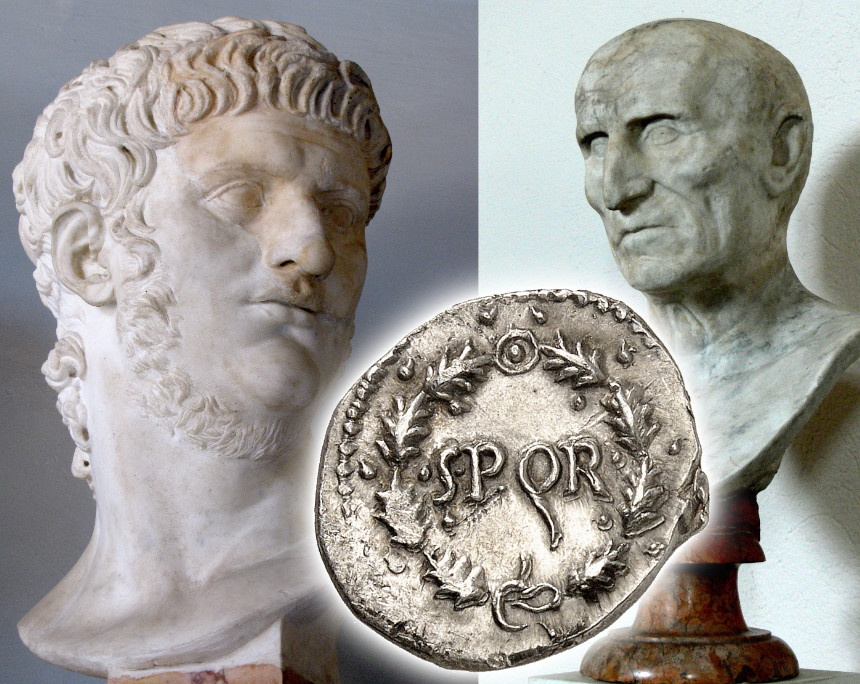
Gaius Julius Vindex. Denarius, between March and May 68, Vienne(?). Extremely rare. Extremely fine. Estimate: 1,500 euros. From Heidelberger Münzhandlung, auction 89 (12 November 2024), No. 113. Photo: Lübke + Wiedemann KG. Background: Bust of Nero at the Capitoline Museum, Rome (cjh1452000 – CC BY-SA 3.0) and Bust of Galba at the Royal Palace, Stockholm. (Wolfgang Sauber / CC BY-SA 3.0).
When exactly did the Roman upper class begin to realize that a certain Nero had to go? Was it after the failed conspiracy of April 65, when Nero had all those murdered who had any kinship with Augustus? Or after the forced suicide of the loyal and respected general Corbulo? A simple rumor had been enough reason for Nero to get rid of this dutiful military leader. And nothing more was needed in the case of the Scribonius brothers, the commanders of the armies of Germania superior and Germania inferior. Their fate must have given pause for thought to all those who commanded an army anywhere in the Roman Empire.
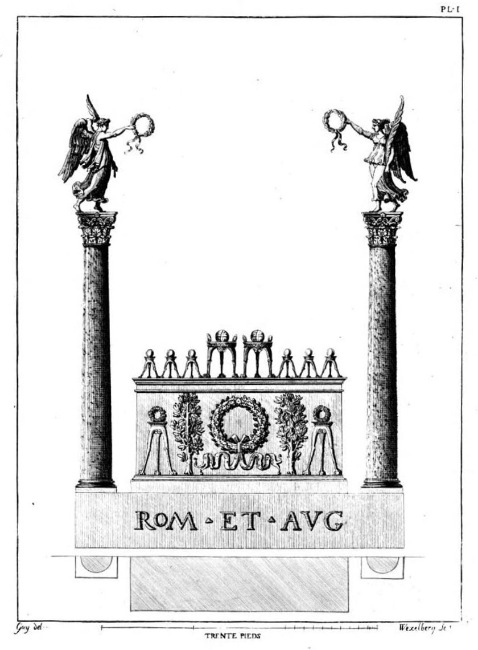
Reconstruction of a Gallic sanctuary for Roma and Augustus as depicted on coins. François Artaud, Discours sur les médailles d’Auguste et de Tibère (1820).
Gaius Julius Vindex
One of these commanders was Gaius Julius Vindex. He was of Celtic descent. His family had already been one of the leading families in Aquitaine during the Gallic War, and Caesar had granted them citizenship. His father even became senator under Claudius. Vindex himself had administered the province of Gallia Lugdunensis since 67. Could it be that he also lived in fear of receiving the emperor’s order to commit suicide? He did not let it come to that. Cassius Dio tells us that in March 68, during the annual assembly at the sanctuary of Augustus and Roma, Vindex called on the delegates of the Gallic cities to revolt: “Rise up at last, help yourselves, help the Romans and liberate the whole universe,” he is said to have urged the assembled dignitaries.

Gaius Julius Vindex. Denarius, between March and May 68, Vienne(?). SALVS GENERIS – HVMANI Victoria on globe to the right, floating in the air, palm and wreath in her hand. Rev. SPQR in oak wreath. RIC 71. Extremely rare. Extremely fine. Estimate: 1,500 euros. From Heidelberger Münzhandlung, auction 89 (12 November 2024), No. 113. Photo: Lübke + Wiedemann KG.
This very appeal seems to be the theme of a series of coins whose connection with Vindex is now considered certain by historians, although neither his name nor his portrait is shown on the pieces. Only few of these rare issues were produced, and many of them depict Victoria. The legend SALVS GENERIS HVMANI – the salvation of mankind – is a complete novelty in Roman numismatics. After all, genus humanum comprises much more than populus romanus. It included not only Roman citizens, but also the inhabitants of the provinces. While Roman coinage had previously focused on the Romans, Vindex inspired his Celtic supporters with new ambitions. He had to rally both the Romans and the provinces behind him. The concept of genus humanum proved so useful in this context that Trajan would later use it again for his coinage.
For the reverse, Vindex chose a wreath of oak leaves with the inscription SPQR for the senate and people of Rome. This design was familiar to anyone who used Roman coins at the time. It was associated with Augustus – the very Augustus who had won and ended the civil war. In gratitude, the senate awarded him a golden wreath of oak leaves. It was reminiscent of the corona civica, which was awarded to anyone who saved the life of a fellow Roman citizen. The golden oak wreath thus signified that Augustus had saved the entire Roman people from the mortal danger of civil war. By using this motif, Vindex pointed to his goal: to live in peace and prosperous coexistence.
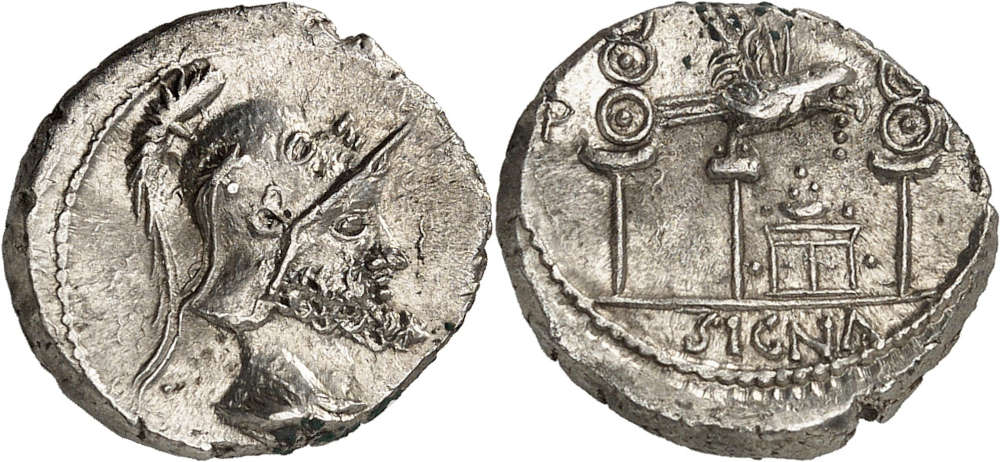
Gaius Julius Vindex. Denarius, between March and May 68, Vienne(?). Head of Mars with helmet to the right. Rev. P-R / SIGNA Altar between two military standards and an eagle. RIC 39. Very rare. About mint state. Estimate: 1,000 euros. From Heidelberger Münzhandlung, auction 89 (12 November 2024), No. 111. Photo: Lübke + Wiedemann KG.
Other coins illustrate that such a goal could only be achieved through battle. Many of these issues were directed at the military. Our example shows the most sacred objects a legion carried – its legionary eagle and military standards. Even Mark Antony had used this motif to gain the loyalty of his legions.
Vindex, however, used a different obverse design. He depicted Mars, who – according to the Roman world view – represented the protection of borders and was the epitome of a just war. Vindex thus emphasized that Nero had overstepped all boundaries and that the fight against him was a just war that would be supported by Mars.
Lucius Sulpicius Galba
Vindex was a realist. He knew that as an Aquitanian Celt he had little chance of presenting himself to the senate as the new emperor. He needed an ally with an impeccable reputation and the trust of the Roman upper classes. So he turned to Galba, the governor of the province Hispania Tarraconensis.
Galba was a member of an old-established family of senators. He owed his rapid rise to Augustus’ wife, Livia. His career had taken him to Aquitaine in the early 30s, which is why we can assume that Vindex’s father knew him personally. He probably told his son of Galba’s discipline and his strong sense of justice. In addition, Galba was over 70 years old and had no children. Who knows, perhaps an adopted son would be able to take over his rule after a few years, regardless of whether this adopted son was of Celtic descent or not…
So Vindex turned to Galba. The latter remained cautious. He neither joined Vindex’s cause nor reported him to the emperor. The emperor is said to have interpreted this omission as treason and ordered Galba’s assassination. This seems to have been the reason why Galba had himself proclaimed Legatus Senatus Populique Romani (and not emperor) in early April.
As general of the senate and people of Rome, he obviously did not have coins with his portrait minted. He, too, opted for anonymous issues, the attribution of which is considered certain today. They were struck in May and in June of 68, probably at the Tarraco mint. One of them is offered at the auction sale of Heidelberger Münzhandlung.

Galba. Denarius, May to June, Tarraco(?). GENIO P R Head of the genius of the Roman people to the right, behind it a cornucopia. Rev. MARTI – VLTORI Helmeted head of Mars in heroic nudity as champion to the right. He throws a spear and protects himself with a shield. RIC 17. Very rare. Extremely fine. Estimate: 2,000 euros. From Heidelberger Münzhandlung, auction 89 (12 November 2024), No. 110. Photo: Lübke + Wiedemann KG.
Galba’s coin designs are, with a few exceptions, muss less warlike than those of Vindex. They focus on pax (= peace), bonus eventus (= a happy end), roma renascens (= Rome reborn), virtus (= all Roman virtues) and Victoria.
But the piece offered by Herbert Grün at his auction at Heidelberger Münzhandlung conveys a military message. It depicts Mars Ultor, who also evoked the memory of Augustus. After the victory of Philippi, the first Roman princeps had a temple built in his honor on the Roman Forum. Like the oak wreath, the god thus is a reminder of the happy end to the Roman civil war brought about by Augustus’ intervention.
The obverse shows the head of the Genius Populi Romani. The Roman concept of a genius was a kind of spirit that represented the very essence of a household. The Genius Populi Romani was an extension of this. It symbolized all the core virtues of the Roman people. Nero had lost sight of these virtues in his excessive enthusiasm for the Greek world. With this coin, Galba wanted to stage himself as a representative of the traditional Rome, of the Rome that upheld virtues such as justice, bravery, loyalty and discipline. The cornucopia must also be interpreted in this context. It represents abundance, i.e., the reward given by the gods to the righteous.
Nero’s Death – A Matter of Poor Communication?
But let us look at what happened on the border between Gaul and Germania. The Battle of Vesontio (= Besançon) was fought there sometime in May 68. After all, Nero did not only have enemies but also supporters. Among them was Lucius Verginius Rufus, governor of Germania superior. He was a homo novus who owed his career to Nero. That is why he defended him and fought against Vindex, who took his own life after his defeat.
Nero probably never found out about this. After a long period of denial, Nero panicked and revealed his complete inability to respond appropriately to a crisis. At the beginning of June, the senate – probably also unaware of Vindex’s defeat – decided to offer the title of emperor to Galba and to declare Nero a hostis (= enemy). In reality, this was a death sentence.
We all know what happened next: Nero killed himself; Galba became emperor. Galba offended Otho by not making him his successor. So Otho staged a coup and became emperor himself after Galba was murdered. Around the same time, the Germanic legions felt that their achievements in the civil war had not been properly recognized and proclaimed Vitellius emperor. The latter defeated Otho, and in turn was defeated by Vespasian’s allies, who thus emerged as the victor of the Year of the Four Emperors.
The Anonymous Coin Issue of the 68/9 Civil War
The civil war of 68/9 confirmed that the Praetorians played the most important role in the struggle for leadership of the Roman Empire. Whoever won their loyalty had the best chance of victory. However, whoever this party was had to pay dearly for the support of the Praetorians. A small series of coins offered at Heidelberger Münzhandlung was probably produced to bribe them. The Praetorians’ concordia (= harmony with) and their fides (= loyalty) are too often referred to for this to be a coincidence.
However, there is no consensus as to who struck these coins, and when and where this happened.
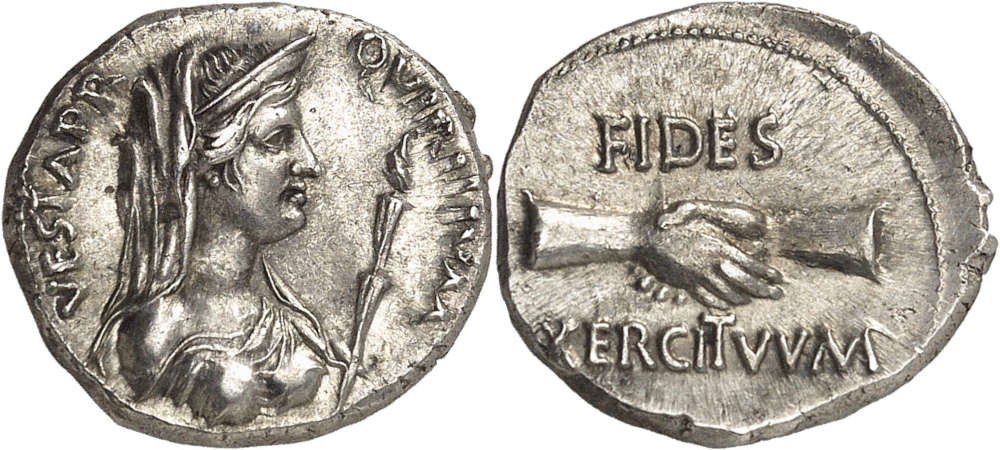
Anonymous. Denarius, 68/9. VESTA PR – QVIRITIVM Veiled bust of Vesta, a burning torch in the right field. Rev. FIDES / EXERCITVVM Handshake. RIC 126. Very rare. Mint state. Estimate: 2,500 euros. From Heidelberger Münzhandlung, auction 89 (12 November 2024), No. 108. Photo: Lübke + Wiedemann KG.
Also included in this series is an extremely rare coin featuring the goddess Vesta on the obverse. She represents that what is most sacred – everything that defined the very essence of Rome. In her temple, the Vestal virgins kept not only the sacred fire, but also various objects believed to have been personally rescued from Troy by Aeneas. These included the Palladion, but also the Penates of the Roman people, the guardian deities who ensured that the citizens of Rome had enough to eat.
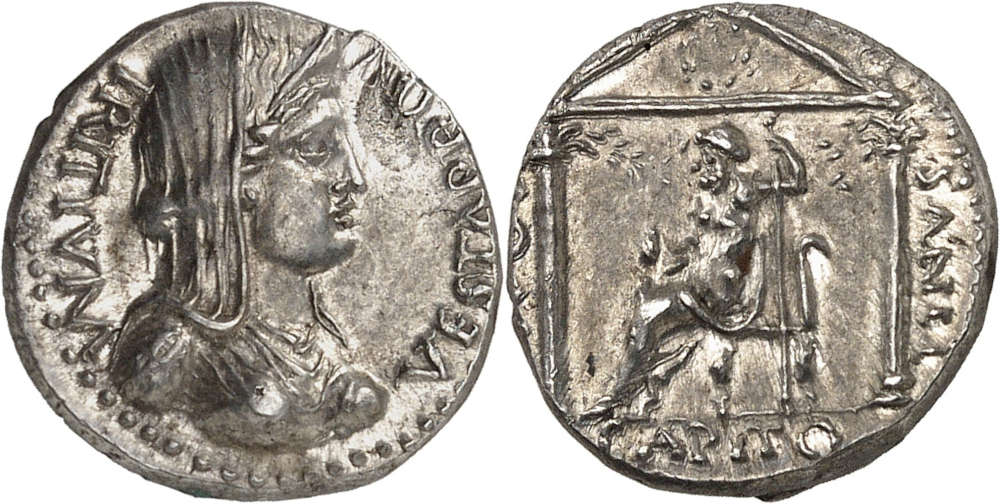
Anonymous. Denarius, 68/9. VESTA PR Q-VIRITIVM Veiled bust of Vesta. Rev. IOM – CAPITO-LINVS Jupiter with thunderbolt and sceptre enthroned to the left in a temple; on the pediment of the temple a wreath. RIC 127b. Extremely rare. About mint state. Estimate: 2,500 euros. From Heidelberger Münzhandlung, auction 89 (12 November 2024), No. 109. Photo: Lübke + Wiedemann KG.
On an extremely rare coin type, Vesta is paired with Jupiter Capitolinus, the most important Roman state god, who, as head of the Capitoline Triad, resided on the Capitoline Hill in the city’s most important sanctuary. It appears that this coin was intended to remind the Praetorians that Rome’s oldest gods were keeping an eye on them to see whether they would remain loyal to their allies.
In reality, things were different. Jupiter did nothing to stop the Praetorians from making a good business out of the civil war. What could Jupiter have done anyway? He was not even able to protect his own temple, which burned down in the street fighting of December 69.
The coins of the Roman civil war of 68/9 document one of the most fascinating periods in Roman history, when rule passed from the descendants of Julius Caesar to successful generals. Only on rare occasions can we see these coins in such exceptional condition. It is therefore well worth taking a close look at the catalogue of Heidelberger Münzhandlung.






